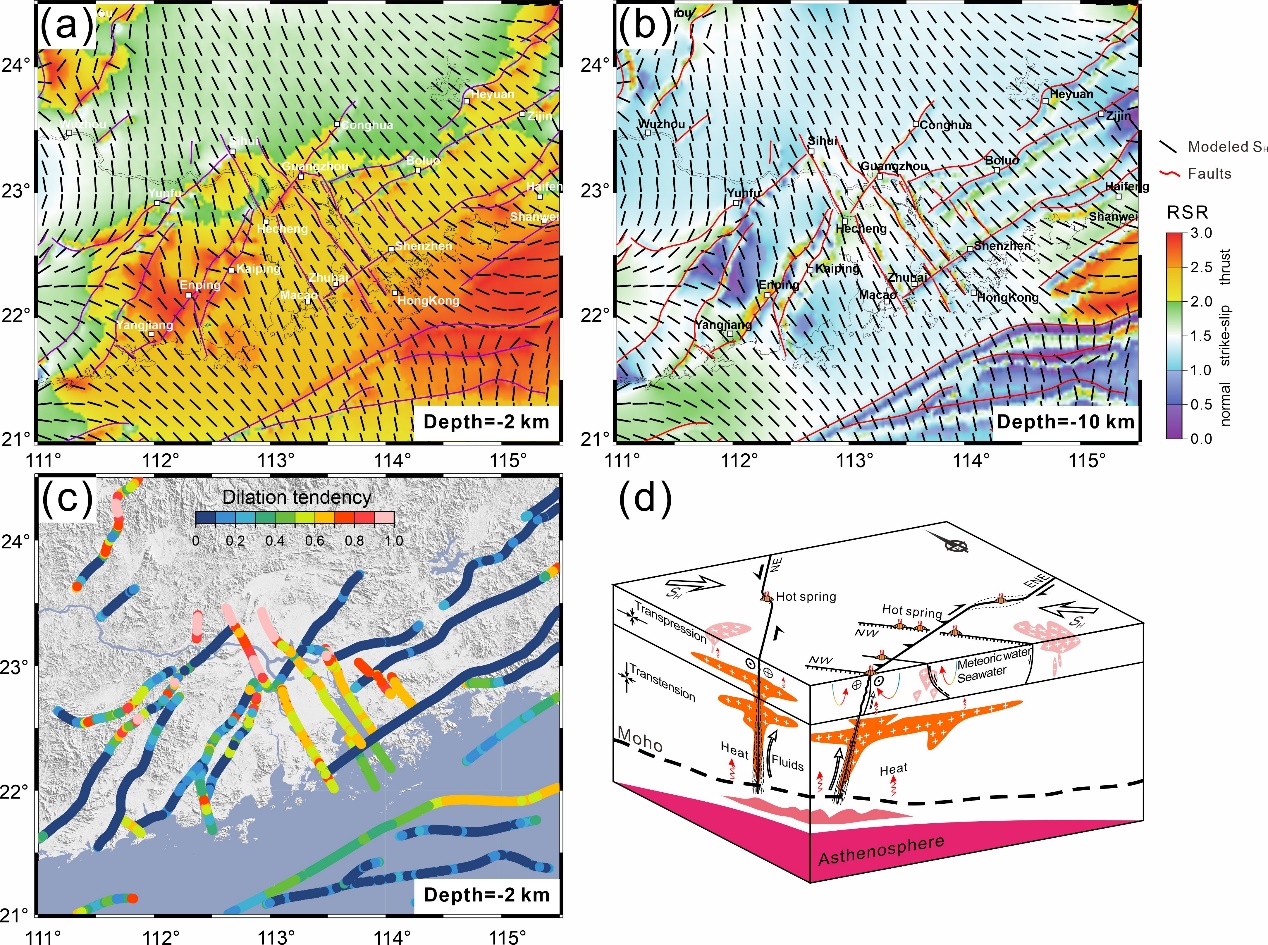Recently in collaboration with experts in related fields at home and abroad, the geothermal research group of Shenzhen University/Guangming Laboratory, led by IAS Professor Shaopeng Huang, has made breakthrough progress in characterizing the crustal stress field and its control over the distribution of geothermal resources in the Guangdong-Hong Kong-Macao Greater Bay Area (GBA).
Geothermal energy, as a clean and renewable energy source, is of great significance to promoting green and low-carbon energy transformation and achieving the goal of "carbon peak and carbon neutrality". The GBA region is rich in deep-circulating hydrothermal resources controlled by deep faults. Stress analysis of heat-controlling structures is a basic work in studying this type of geothermal system. The results can effectively improve the efficiency of geothermal exploration and reduce the risks and costs of geothermal resource development. However, the characteristics of the crustal stress in the GBA are still unclear, which hinders people's understanding of the genetic mechanism of the geothermal system and development of geothermal resources.
Recently, the research team obtained three-dimensional crustal absolute stress field of the GBA by constructing a high-resolution three-dimensional geomechanical model of the GBA containing a complex fault system. The model simulation results show that there are obvious lateral and vertical changes in the crustal stress field. Roughly bounded by the Pearl River Estuary, the eastern part of the GBA is under the NW-SE compression, whereas the western part is under the near N-S compression; the shallow crust is mainly in a transpressional stress state, while the deep crust stress state is transtensional. The spatial variation of this stress field directly affects the stress state of each fault in the region, making the shallow NW faults and the deep NE/NEE faults tensional and transtentional, favorable for geothermal fluid circulation.
Based on the above results, the research team proposed a conceptual model of the geothermal system in the GBA: the heat generated by deep heat sources (including mantle heat and radioactive heat generation of granite) is transmitted to the shallow crust through conduction and deep circulating geothermal fluids. However, due to the change of shallow stress state, the NE/NEE faults become compressive and the permeability decreases, forcing these geothermal fluids to gather near the shallow faults, forming a macroscopic NE-trending geothermal anomaly belt. When the structural conditions are suitable, for example, when there are secondary NW faults that intersect with the NE/NEE faults, the geothermal fluids will migrate upward along the channels provided by the highly permeable NW faults, mixing with shallow atmospheric precipitation/seawater on the way, and finally forming hot springs distributed in clusters along the NW faults. This study explains the geothermal distribution pattern of "NE faults controlling heat and NW faults controlling water" in the GBA from the perspective of crustal stress. The result can also help delineate the prospect areas of geothermal resources in the region.
In addition, geothermal energy and earthquake are two natural phenomena closely related to the crustal stress field. The research team also compared and analyzed the seismogenic structures and stress characteristics of two historical strong earthquakes in the study area, namely the M6.1 Xinfengjiang earthquake in 1962 and the M6.4 Yangjiang earthquake in 1969. It is believed that the NEE-trending fault group in the GBA is nearly perpendicular to the regional compression direction and can accumulate high strain energy. It is recommended that in the future geothermal development and related large-scale infrastructure projects, special attention should be paid to the seismic risk of this group of faults. The stress field simulation results obtained in this study have compensated the lack of sparse stress data in the GBA and are helpful to understand the geothermal distribution pattern and formation mechanism in the region from the dynamic perspective, which further provide important scientific support for exploring hidden geothermal systems, rationally evaluating geothermal resources, and analyzing the seismic risk of the GBA.
On January 15, 2025, this work was published online on the website of Geothermics, a mainstream international geothermal journal. The first author of the paper is Associate Researcher Xianrui Li of Guangming Laboratory/Shenzhen University. Professor Shaopeng Huang and Dr. Xianrui Li are co-corresponding authors. Collaborators include Dr. Tobias Hergert from Karlsruhe Institute of Technology, Germany, Professor Andreas Henk from Technical University of Darmstadt, Germany, and Research Assistant Professor Danhua Xin from Southern University of Science and Technology. This research was jointly funded by the National Natural Science Foundation of China (U20A2096, 42204054), the Basic and Applied Basic Research Fund of Guangdong Province (2023A1515110289) and the Shenzhen Stable Support Plan Program for Higher Education Institutions (20220815084720001).
The original paper can be found at https://doi.org/10.1016/j.geothermics.2025.103253 (Li, X., Huang, S., Hergert, T., Henk, A., Xin, D., 2025. Contemporary crustal stress in the Guangdong-Hong Kong-Macao Greater Bay Area, SE China: Implications for geothermal resource exploration and seismic hazard assessment. Geothermics 127, 103253).

(a) Modeled SH orientation (denoted by the black bars) and stress regime at 2 km depth below sea level. (b) Modeled SH orientation and stress regime at 10 km below sea level. (c) Dilation tendency on the faults at a depth of 2 km below sea level. (d) Schematic diagram of the fault-controlled geothermal systems in the GBA.


